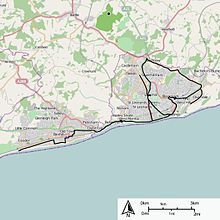Hastings and District Electric Tramways
| Hastings and District Electric Tramways | |
|---|---|
 Map of the routes of the Hastings and District Electric Tramways | |
| Operation | |
| Locale | Hastings |
| Open | 31 July 1905 |
| Close | 15 May 1929 |
| Status | Closed |
| Infrastructure | |
| Track gauge | 3 ft 6 in (1,067 mm) |
| Propulsion system(s) | Electric |
| Statistics | |
| Route length | 19.57 miles (31.49 km) |
Hastings and District Electric Tramways operated a tramway service in Hastings between 1905 and 1929.[1]
History[]

The tramway opened in two sections which operated independently until 1907. Following the passing of legislation permitting the installation of the tramways,[2] services started in Hastings on 31 July 1905. The depot was located in Silverhill at TQ 8017 1067.
A second depot was built at Bulverhythe (TQ 7815 0880) for services between St Leonards-on-Sea and Bexhill which started on 9 April 1906. That line finally reached Cooden Beach on 28 July 1906. On 12 January 1907, the two systems were connected along the seafront.
The trams ran as far as Bexhill, and were worked by overhead electric wires, except for the stretch along the seafront from Bo-Peep to the Memorial, which was initially worked by the Dolter Stud contact system due to concerns that the overhead cabling would obstruct sea views, a sentiment that was cemented in the legislation permitting the tram service. Following unsuccessful attempts to mount trams for this route with a small petrol engine/generator combination and a further act of Parliament,[2] overhead electrification was extended to this section in 1921.
Closure[]
Under the 1905 Act, the councils had an option to buy Hastings Tramway Co. in 1925. They didn't, so the company reviewed its options. The tramway service closed on 15 May 1929 and was replaced by trolleybuses on the same routes, except for a short section of private right of way on Pebsham Marsh, off Bexhill Rd and a new link through High St.[3]
Two tramcars survive, 48 and 56. Both are under restoration by the Hastings Tramway Club.
References[]
- ^ The Golden Age of Tramways. Published by Taylor and Francis.
- ^ a b Historical Hastings Wiki: Tram - Historical Hastings Wiki, accessdate: 16 January 2020
- ^ Buses August 1970: Ian Allan J Joyce & A G Newman pages 295-99
External links[]
- Tram transport in England
- 3 ft 6 in gauge railways in England
- Transport in Hastings
 WikiMiniAtlas
WikiMiniAtlas